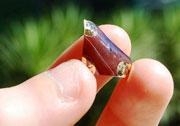Plastics get electric
A newly discovered technique makes it possible to create a whole new array of plastics with metallic or even superconducting properties.
A newly discovered technique makes it possible to create a whole new array of plastics with metallic or even superconducting properties.

A newly discovered technique makes it possible to create a whole new array of plastics with metallic or even superconducting properties.
Plastics usually conduct electricity so poorly that they are used to insulate electric cables but, by placing a thin film of metal onto a plastic sheet and mixing it into the polymer surface with an ion beam, Australian researchers have shown that the method can be used to make cheap, strong, flexible and conductive plastic films.
The research has been published in the journal ChemPhysChem by a team led by Professor Paul Meredith and Associate Professor Ben Powell, both at the University of Queensland, and Associate Professor Adam Micolich of the UNSW School of Physics. This latest discovery reports experiments by former UQ PhD student, Dr Andrew Stephenson.
To demonstrate a potential application of this new material, the team produced electrical resistance thermometers that meet industrial standards. Tested against an industry standard platinum resistance thermometer, it had comparable or even superior accuracy.
"This material is so interesting because we can take all the desirable aspects of polymers - such as mechanical flexibility, robustness and low cost - and into the mix add good electrical conductivity, something not normally associated with plastics," says A/Professor Micolich. "It opens new avenues to making plastic electronics."
Read the full story at the Faculty of Science newsroom.
UNSW media contacts: Adam Micolich, (02) 9385 6132 | Media liaison, Pete Trute 0410 271826